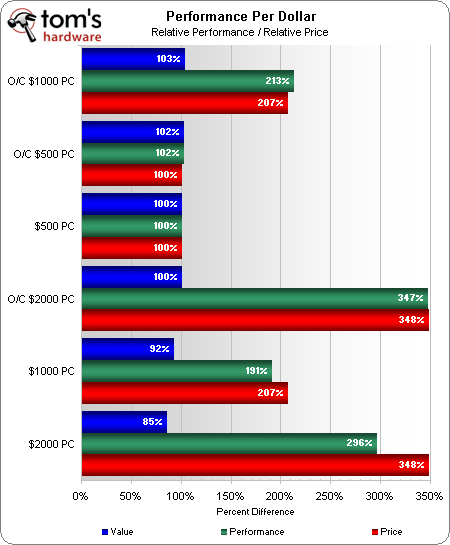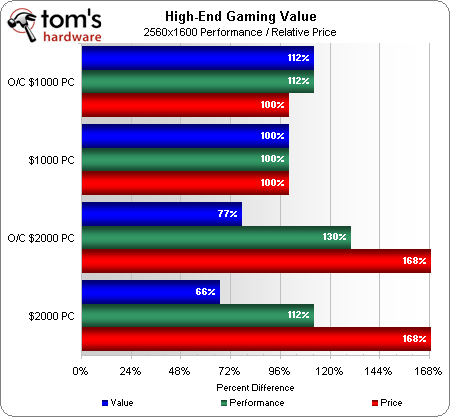System Builder Marathon, June 2012: System Value Compared
Crowning A Value Winner
The lowest-cost build usually wins our performance-per-dollar comparison, though we typically have to flag it with a caveat that most performance seekers probably won't be satisfied with its speed.
This time could be different, though, since a boost in the little machine's GPU performance came at a serious cost: its CPU budget. Might the $1000 system, or even (cough) my $2000 build win this race?
For the fist time in recent memory, the mid-priced build tops our value charts. The only configuration to fall behind is the $2000 at its stock settings; overclocking is required to justify its added expense. Fortunately, I picked an overclockable CPU, which responded well to tuning.
The $1000 PC performed so well and presented so much value that I'm almost ready to give its parts list a mass recommendation. The one shortfall holding me back is that its case was simply garbage. Fortunately, a suitable replacement shouldn’t be very difficult to find near its $42 price.
The $1000 PC’s other shortcoming is one that, if fixed, could have boosted its value score. The unlocked Core i5-2500K would have added only $30 to the system, and a more adequate cooler another $20 or so. CPU overclocking is a time-proven way to bolster performance at minimal cost, so a roughly 5% budget increase might have returned a two to threefold increase in benchmark performance.
As for the $500 build's second-place value finish, even its builder admitted that the machine would be woefully inadequate for anything beyond the scope of gaming. While it’s hard for many of us to recommend a machine exclusively for that purpose, some folks do nothing but game and surf the Web on their PCs. For them, the entry-level system's limitations aren't debilitating at all.
Finally, there’s the matter of gaming at high resolutions. This is typically where the most expensive configuration shines. But the $1000 build’s Radeon HD 7970 performed amazingly well in spite of the system’s low memory capacity and moderate CPU frequency:
This chart almost shows that a high-end gaming-oriented PC is overkill (at least at the resolutions we're using for testing). We paid much more for a higher-end PC with lots of memory, but without a corresponding return on our investment. There’s also the expense of an SSD, which improves game loading times, but hasn't had much of an effect in-game since we stopped testing the original Crysis.
And so, the almost-excellent $1000 build almost gets our recommendation. With a couple of little alterations (and a slightly higher cost) we end up asking: would anyone like a $1100 Enthusiast PC?
Get Tom's Hardware's best news and in-depth reviews, straight to your inbox.
-
Crashman mayankleoboy1toms, y u no include Quicksync benchies?Because it would be mean to the lower-cost PC builders? The truth is that the two applications that use it didn't appear all that popular with our readers.Reply -
mayankleoboy1 the only reason i see to buy a IB over a SB is better quicksync. Rest, they are same.Reply -
blazorthon mayankleoboy1the only reason i see to buy a IB over a SB is better quicksync. Rest, they are same.Reply
Replace the paste under the IHS on Ivy Bridge and those 3570Ks and 3770Ks overclock better than their Sandy counterparts. The IGP is also good for more than Quick-Sync. -
Crashman blazorthonReplace the paste under the IHS on Ivy Bridge and those 3570Ks and 3770Ks overclock better than their Sandy counterparts. The IGP is also good for more than Quick-Sync.And even with the stock IHS implementation, the power savings of Ivy at 1.25V looks good compared to Sandy at 1.35V (assuming both voltage levels get you to 4.6 GHz, which is approximately true).Reply -
blazorthon CrashmanAnd even with the stock IHS implementation, the power savings of Ivy at 1.25V looks good compared to Sandy at 1.35V (assuming both voltage levels get you to 4.6 GHz, which is approximately true).Reply
Yes, thanks. I forgot to mention the improved power efficiency from the new process node. -
jestersage As I indicated in the Gaming PC comments, I'm good with Paul's $500 experiment. But an Enthusiast PC at $1100? I figure you'll want to alter all those parts that got Don those un-edifying comments, then yeah! Bring it on!Reply
Aside from the 2500k, stick a GTX 670 in that thing I'll bet we'll have a real winner (depends on Tom's rules, I guess, since that part wasn't available at the time the SBM purchases were originally made).
Or step down to a 7870 and stick an SSD in it - for all those clamoring that a $1000 PC should have an SSD. -
blazorthon jestersageAs I indicated in the Gaming PC comments, I'm good with Paul's $500 experiment. But an Enthusiast PC at $1100? I figure you'll want to alter all those parts that got Don those un-edifying comments, then yeah! Bring it on! Aside from the 2500k, stick a GTX 670 in that thing I'll bet we'll have a real winner (depends on Tom's rules, I guess, since that part wasn't available at the time the SBM purchases were originally made). Or step down to a 7870 and stick an SSD in it - for all those clamoring that a $1000 PC should have an SSD.Reply
670 or 7970... Not much of a difference there. The two are effectively on-par with each other, trading blows depending on the game, resolution, and settings. Why not step down to a 7950, get a cheap SandForce SSD, and then up the CPU to the 2500K, all without even sacrificing graphics performance when overclocked? 7950s and 7970s that share a PCB and cooler have pretty much identical overclocking performance with the 7970s having an in-perceptively small advantage at the same frequency and the 7950 able to hit slightly higher frequencies.



